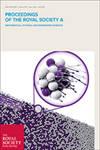受限PBX 9501的热熄火响应
Proceedings of the Royal Society of London. Series A. Mathematical and Physical Sciences
Pub Date : 2004-12-08
DOI:10.1098/rspa.2004.1348
引用次数: 33
摘要
从安全的角度来看,含能材料的热烧退反应(由直接、大量热加热引起的点火)很重要,但也挑战了我们对这些材料的理解。炸药不是被设计用来煮掉的,尤其是在缓慢煮掉的情况下,当材料被点燃时,它在化学上和物理上都与原始状态有很大的不同。在试图对这一过程进行数值模拟时,通常假设燃烧从一个着火点开始,以或多或少的平面方式进行,正如在室温下的原始含能材料中多次观察到的那样。为了直接研究一种含能材料(PBX 9501)燃烧后反应的扩散,我们用一个封闭玻璃或蓝宝石窗加热PBX 9501的小圆盘,通过高速摄影可以直接观察到燃烧过程的早期阶段。结果发现,燃烧随著着火温度的变化而变化,但在所有情况下都与层流燃烧模型有很大不同。提出了这些测试的结果,以及对这种行为的一些可能的解释,并讨论了对这种反应建模的影响。本文章由计算机程序翻译,如有差异,请以英文原文为准。
Thermal cook–off response of confined PBX 9501
The thermal cook–off response of energetic materials (ignition resulting from direct, bulk thermal heating) is important from a safety point of view, but also challenges our understanding of these materials. Explosives are not designed to be cooked off, and, especially in the case of slow cook–off, by the time the material ignites it is substantially different, both chemically and physically, from its original state. In attempting to model such a process numerically, it has generally been assumed that combustion proceeds, from an ignition point, in a more or less planar manner, as has been observed many times in pristine energetic materials at room temperature. To investigate directly the spread of reaction following cook–off in one such energetic material (PBX 9501), small discs of PBX 9501 were heated with a confining glass or sapphire window through which the early stages of the combustion process could be observed directly by high–speed photography. The resulting combustion was found to vary with temperature of ignition, but in all cases was quite different to the laminar burn model. The results of these tests are presented, together with some possible explanations of the behaviour and discussion of the implications to modelling this response.
求助全文
通过发布文献求助,成功后即可免费获取论文全文。
去求助
来源期刊
自引率
0.00%
发文量
0
期刊介绍:
Proceedings A publishes articles across the chemical, computational, Earth, engineering, mathematical, and physical sciences. The articles published are high-quality, original, fundamental articles of interest to a wide range of scientists, and often have long citation half-lives. As well as established disciplines, we encourage emerging and interdisciplinary areas.

 求助内容:
求助内容: 应助结果提醒方式:
应助结果提醒方式:


